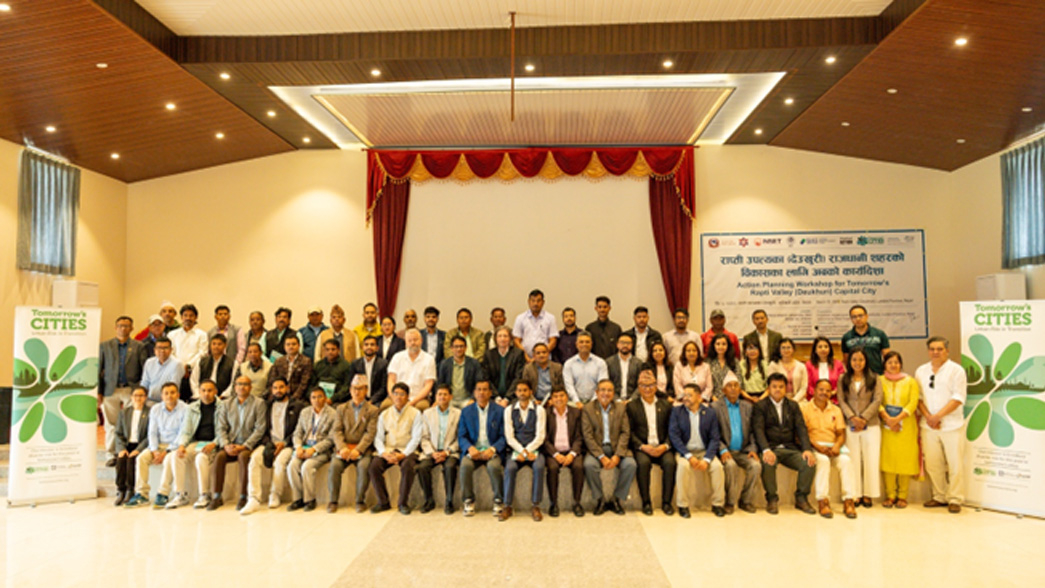
- Close
26/04/2024 | Rapti
Tomorrow’s Cities in Rapti paves path for new cities in Nepal

Tomorrow’s Cities in Rapti has accomplished the task of refining the Master Plan of Rapti, the Lumbini Province Capital City (LPCC) through engagement and contribution of various local & national stakeholders, and scientific communities with the view to ensure better-planned, sustainably developed, disaster-resilient and socially equitable future city is built. The need to replicate this risk-informed urban development planning approach in other Nepali cities has become evident. It is believed that Tomorrow’s Cities in Rapti has paved the way for the development of new cities in Nepal.

Addressing Action Planning Workshop under Tomorrow’s Cities, Ms. Radhika Aryal, Principal Secretary, Lumbini Province expressed the commitment of province government to incorporate inputs in Master Plan and implement them. “We have recently finalized the revised Master Plan for the Capital City of Lumbini Province, on behalf of the Provincial Government, I assure you of our commitment to implementing this plan in order to enhance the beauty of our provincial capital”, Principal Secretary Ms. Aryal remarked. Ms. Aryal expressed her commitment to city planning that not only caters to the present but also considers the needs of the city for the next 50 years. Ms. Aryal also requested the assistance of partner organizations in providing the necessary resources for the implementation of the master plan.
Mr. Anil Pokhrel, Executive Chief of National Disaster Risk Reduction and Management Authority (NDRRMA) stated, “Our primary objective is to explore ways to expand the application of risk-informed urban development planning from Rapti to other cities and eventually on a nationwide scale”. Mr. Pokhre pointed out challenges in terms of coordinating and harmonizing between these different local governments to take forward the implementation of Rapti Master Plan. “Only the large infrastructures alone do not make a good and healthy city. If the city is properly planned, it can contribute to the overall health and well-being of the inhabitants, he added.
Prof. Mark Pelling, Director for Tomorrow’s Cities suggested that Provincial Infrastructure Development Authority (PIDA) and other government stakeholders should move forward with the coordination and cooperation of various organizations to execute the plan. “We truly appreciate the People of Rapti, the three mayors who spoke today, the Lumbini Province Government, and NDRRMA for exemplifying collaboration in Nepal and Rapti. All we have done through TC is to provide a purpose for collaboration”, Prof. Pelling added, “ regarding the question of how to move forward, the answer is more collaboration. Today’s meeting marks not the end of the project but a milestone in our journey. Three broader lessons have emerged: the work and methodology of Rapti City have already influenced initiatives in other cities”. Prof. Pelling emphasized, “the experiences we gained from Rapti City have been leveraged in nine other cities where similar work is being implemented”.
Dr. Amod Mani Dixit, President of NSET, acknowledged that to get the opportunity to work in Rapti with experts had been delightful, and he also felt challenged to continue this collaboration into the future. “Local planning must relate to national planning since many things are in common between these two. Trans-disciplinary efforts and collaboration are important, while vertical & horizontal relations are equally important. We are glad to learn that the activities in Rapti have been an example for other cities as well,” Dr. Dixit shared.
Mr. Chhabi Raj Pokhrel, Chief Executive Officer of the Provincial Infrastructure Development Authority (PIDA), Lumbini Province, shared that the Tomorrow’s Cities Project has accomplished the research work in Rapti based on the experiences and lessons learned from Khokana, Lalitpur. “Basically, we wanted to look at how to make Rapti Valley, surrounded by Chure, jungles, and rivers, safer from earthquakes, floods, landslides, and fire hazards. We are committed to incorporating the findings and aspirations of all the people, including indigenous, marginalized, ethnic groups, migrants, and low-income groups. Experts from NSET, IOE, PA, NDRI and SIAS extensively discussed issues of hazards in future Rapti. The elected officials have also taken this in,” Mr. Pokhral remarked.
If urban development is unplanned and unregulated, there will be a mismatch between housing, infrastructure development and the growing population. If land uses are not carefully planned, schools and homes will be built next to dangerous factories and busy roads, and there may not be enough hospitals, green spaces, and leisure facilities for people to live healthy and fulfilling lives. The impact of future natural hazards and climate change on these cities may not be considered, and the opinions and needs of the poorest and marginalized groups within these cities may not be considered in the planning process.
Aimed at reducing risk in future urban developments, the Tomorrow’s Cities uses a collaborative and co-creation approach with the involvement of local stakeholders, giving voice not only to the planning authorities, municipalities, the government and the private sector, but also to the communities who will live in these future cities.
An “Action Planning Workshop for Tomorrow’s Rapti Valley (Deukhuri) Capital City” was successfully organized in Rapti Valley (Deukhuri), Lamahi on March 22, 2024. The main objective of this one-day workshop was to share important research findings to government officials and different stakeholders; and engage them in discussions regarding the processes and efforts aimed at shaping the future of Rapti City.
This initiative was organized by Provincial Infrastructure Development Authority (PIDA), Lumbini Province and Tomorrow’s Cities in association with Shiataganga Municipality, Rapti Rural Municipality and Gadhawa Rural Municipality.
There were 2 Panel Discussions held.
Panel Discussion 1: Further refinement and implementation of Master Plan of the Rapti Valley (Deukhuri)
The first panel discussion was on the further refinement and implementation of the revised Master Plan of the Rapti Valley (Deukhuri). Dr. Suresh Chaudhary facilitated the session while the panelists were Mr. Madhav Bhattarai, Secretary of the Ministry of Physical Infrastructure (Session Chair); Mr. Chhabi Raj Pokhrel, CEO of PIDA; Mr. Chabi Lal Poudel, Mayor of Shitaganga Municipality; Mr. Prakash Bista, Chairperson of Rapti Rural Municipality; Mr. Yam Narayan Sharma, Chairperson of Gadhwa Rural Municipality; and Dr. Max Hope, Leeds Beckett University, UK.

During the session, Mr. Chhabi Raj Pokhrel presented keynote on the city’s master plan, emphasizing revisions made through Tomorrow’s Cities and urging panelists to contribute to facilitate and support on its implementation. The mayors commended the project’s efforts, recommended further refinement of the master plan, and stressed the provincial government’s pivotal role and budget allocation requirement for implementation. They advocated for collaborative efforts among the provincial government, PIDA, and local authorities for smooth implementation.
Dr. Max Hope emphasized the consideration of seismic risks, the importance of enhancing local capacity, and sharing the master plan with the stakeholders. He mentioned that it is important to develop inclusive and participatory planning processes which are important for seamless execution and implementation.
Mr. Chhabi Raj Pokhrel expressed a firm commitment to executing the master plan, highlighting PIDA’s role as both the operational team and the authorized entity for this endeavor.
Participants, including Ms. Bandana Sharma from UN Habitat, suggested utilizing existing government data and fostering coordination between local and provincial governments. Feedback from the audience proposed smooth coordination between local government and Provincial government, addressing land pooling issues and preserving cultural sites in future planning.
As session chair, Mr. Madhav Bhattarai, summarized the discussion, expressing appreciation for Tomorrow’s Cities’ work in Rapti. He affirmed the feasibility of implementing the master plan and assured support from the provincial government.
Panel Discussion 2: Institutionalization of TCDSE approach at Province and National level
The second panel discussion centered on institutionalizing the TCDSE approach across provinces and the country. Dr. Ramesh Guragain from NSET moderated the session, with Mr. Anil Pokhrel, CEO of NDRRMA, serving as the session chair. Other panelists included Mr. Rameshwor Marahattha, Joint secretary of NDRRMA; Mr. Narulal Chaudhary, Mayor of Ghorahi Sub-Metropolitan City and General Secretary of Municipality Association Nepal (MuAN); Ms. Laxmi Yogi, Deputy Mayor of Lamahi Municipality; Mr. Jaya Ram Uprety from MoFAGA; Professor Mark Pelling, Director-TC, and Mr. Surya Narayan Shrestha, Executive Director of NSET.

Dr. Ramesh Guragain delivered keynote presentation on the TCDSE approaches, emphasizing participation, future-oriented thinking, risk informed planning, and capacity building. This panel discussion focused on actions needed at local, provincial, and national levels to institutionalize TC initiatives.
Mr. Jaya Ram Upreti highlighted MoFAGA’s role as a bridge between provincial and local governments, particularly in urban planning projects.
Ms. Laxmi Yogi emphasized the importance of sustainability and development without destruction in future city planning.
Mr. Narulal Chaudhary stressed the necessity of supportive policies for development and infrastructure, citing the importance of considering local needs and adhering to building codes.
Mr. Rameshwor Marahattha welcomed the integration of disaster risk into the TCDSE, outlining NDRRMA’s efforts in hazard assessment and risk mitigation protocols involving various stakeholders.
Prof. Mark Pelling suggested that more collaboration with stakeholders is key. He mentioned that the work and methodology of Rapti have already influenced initiatives in other cities internationally. The experience gained from Rapti have been leveraged in nine other cities where similar work is being implemented. He highlighted the three key elements of TC support in Rapti: Science (hazard assessment), Voice (perspective of stakeholders) and Action. Both science and voice have instilled a sense of responsibility to act. This meeting signifies a shift from collaboration—ensured by science and voice—to action.
Mr. Surya Narayan Shrestha commended the refined approach of TC in Rapti and suggested wider dissemination of project outcomes and also in Kathmandu, advocating for increased private sector involvement due to limited government resources.
Participants highlighted the importance of resolving land pooling issues before implementing the master plan and proposed aligning national-level projects with local initiatives for institutionalization.
Mr. Anil Pokhrel recommended establishing a robust legal and policy framework, ensuring clarity on sustainable development and marginalized group inclusion, and securing adequate financial resources for implementation and institutionalization. He also expressed commitment to the institutionalization of TCDSE/risk informed planning.
Exhibition of Posters & Interactive Dashboard
At the beginning, Exhibition of Posters & Interactive Dashboard held showcasing TCDSE process and activities. The poster and Dashboard exhibition effectively displayed the activities and outcomes of Tomorrow’s Cities employing the TCDSE in Rapti. Workshop guests and participants toured the exhibition and interacted with program team on the process and efforts.

For more information, visit https://tomorrowscities.org/tomorrows-rapti and/or write to ksenoli@nset.org.np .


